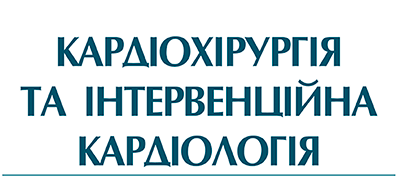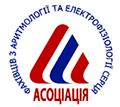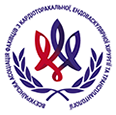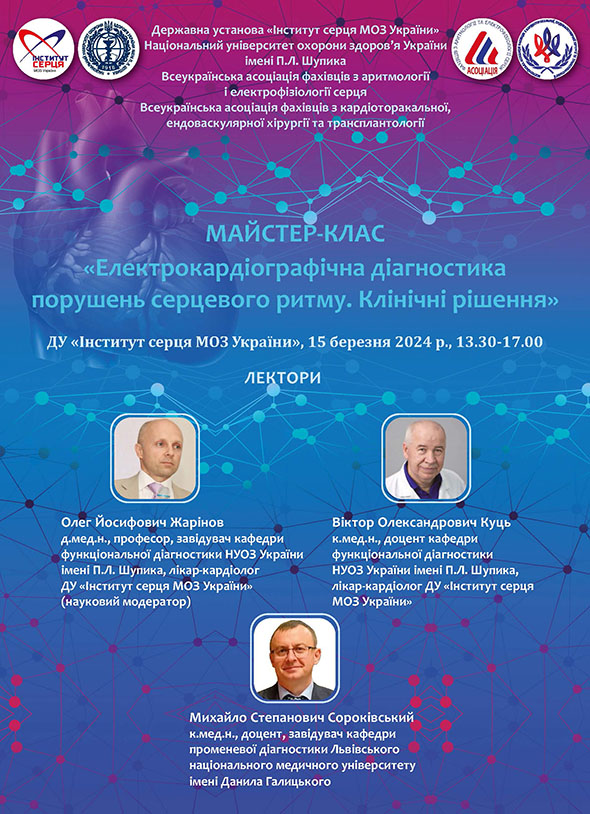Механічні ускладнення інфаркту міокарда: наукова заява Американської асоціації серця
A.A. Damluji, S. van Diepen, J.N. Katz, V. Menon, J.E. Tamis-Holland, M. Bakitas, M.G. Cohen, L.B. Balsam, J. Chikwe, від імені Ради з клінічної кардіології Американської асоціації серця; Ради з атеросклерозу, тромбозу та судинної біології; Ради з кардіохірургії та анестезіології; та Ради з медсестринства у сфері кардіології та інсульту
Література
1. Benjamin EJ, Virani SS, Callaway CW, Chamberlain AM, Chang AR, Cheng S, Chiuve SE, Cushman M, Delling FN, Deo R, et al; on behalf of the American Heart Association Council on Epidemiology and Prevention Statistics Committee and Stroke Statistics Subcommittee. Heart disease and stroke statistics—2018 update: a report from the American Heart Association. Circulation. 2018;137:e67–e492. doi: 10.1161/CIR.0000000000000558
2. Damluji AA, Bandeen-Roche K, Berkower C, Boyd CM, Al-Damluji MS, Cohen MG, Forman DE, Chaudhary R, Gerstenblith G, Walston JD, et al. Percutaneous coronary intervention in older patients with ST-segment elevation myocardial infarction and cardiogenic shock. J Am Coll Cardiol. 2019;73:1890–1900. doi: 10.1016/j.jacc.2019.01.055
3. Peterson ED, Shah BR, Parsons L, Pollack CV Jr, French WJ, Canto JG, Gibson CM, Rogers WJ. Trends in quality of care for patients with acute myocardial infarction in the National Registry of Myocardial Infarction from 1990 to 2006. Am Heart J. 2008;156:1045–1055. doi: 10.1016/j.ahj.2008.07.028
4. Damluji AA, Forman DE, van Diepen S, Alexander KP, Page RL 2nd, Hummel SL, Menon V, Katz JN, Albert NM, Afi J, et al; on behalf of the American Heart Association Council on Clinical Cardiology and Council on Cardiovascular and Stroke Nursing. Older adults in the cardiac intensive care unit: factoring geriatric syndromes in the management, prognosis, and process of care: a scientific statement from the American Heart Association. Circulation. 2020;141:e6–e32. doi: 10.1161/CIR.0000000000000741
5. O’Gara PT, Kushner FG, Ascheim DD, Casey DE Jr, Chung MK, de Lemos JA, Ettinger SM, Fang JC, Fesmire FM, Franklin BA, et al. 2013 ACCF/AHA guideline for the management of ST-elevation myocardial infarction: a report of the American College of Cardiology Foundation/American Heart Association Task Force on Practice Guidelines. Circulation. 2013;127:e362– e425. doi: 10.1161/CIR.0b013e3182742cf6
6. Ibánez B, James S, Agewall S, Antunes MJ, Bucciarelli-Ducci C, Bueno H, Caforio ALP, Crea F, Goudevenos JA, Halvorsen S, et al. 2017 ESC Guidelines for the management of acute myocardial infarction in patients presenting with ST-segment elevation. Rev Esp Cardiol (Engl Ed). 2017;70:1082. doi: 10.1016/j.rec.2017.11.010
7. Rogers WJ, Frederick PD, Stoehr E, Canto JG, Ornato JP, Gibson CM, Pollack CV Jr, Gore JM, Chandra-Strobos N, Peterson ED, et al. Trends in presenting characteristics and hospital mortality among patients with ST elevation and non-ST elevation myocardial infarction in the National Registry of Myocardial Infarction from 1990 to 2006. Am Heart J. 2008;156:1026– 1034. doi: 10.1016/j.ahj.2008.07.030
8. Puerto E, Viana-Tejedor A, Martínez-Sellés M, Domínguez-Pérez L, Moreno G, Martín-Asenjo R, Bueno H. Temporal trends in mechanical complications of acute myocardial infarction in the elderly. J Am Coll Cardiol. 2018;72:959–966. doi: 10.1016/j.jacc.2018.06.031
9. French JK, Hellkamp AS, Armstrong PW, Cohen E, Kleiman NS, O’Connor CM, Holmes DR, Hochman JS, Granger CB, Mahaffey KW. Mechanical complications after percutaneous coronary intervention in ST-elevation myocardial infarction (from APEX-AMI). Am J Cardiol. 2010;105:59–63. doi: 10.1016/j.amjcard.2009.08.653
10. Moreyra AE, Huang MS, Wilson AC, Deng Y, Cosgrove NM, Kostis JB; MIDAS Study Group (MIDAS 13). Trends in incidence and mortality rates of ventricular septal rupture during acute myocardial infarction. Am J Cardiol. 2010;106:1095–1100. doi: 10.1016/j.amjcard.2010.06.013
11. Rao SV, Schulman KA, Curtis LH, Gersh BJ, Jollis JG. Socioeconomic status and outcome following acute myocardial infarction in elderly patients. Arch Intern Med. 2004;164:1128–1133. doi: 10.1001/ archinte.164.10.1128
12. Elbadawi A, Elgendy IY, Mahmoud K, Barakat AF, Mentias A, Mohamed AH, Ogunbayo GO, Megaly M, Saad M, Omer MA, et al. Temporal trends and outcomes of mechanical complications in patients with acute myocardial infarction. JACC Cardiovasc Interv. 2019;12:1825–1836. doi: 10.1016/j.jcin.2019.04.039
13. Goldsweig AM, Wang Y, Forrest JK, Cleman MW, Minges KE, Mangi AA, Aronow HD, Krumholz HM, Curtis JP. Ventricular septal rupture complicating acute myocardial infarction: incidence, treatment, and outcomes among Medicare beneficiaries 1999–2014. Catheter Cardiovasc Interv. 2018;92:1104–1115. doi: 10.1002/ccd.27576
14. Randomised trial of intravenous streptokinase, oral aspirin, both, or neither among 17,187 cases of suspected acute myocardial infarction: ISIS-2. ISIS-2 (Second International Study of Infarct Survival) Collaborative Group. Lancet. 1988;2:349–360. doi: 10.1016/S0140-6736(88)92833-4
15. Keeley EC, Boura JA, Grines CL. Primary angioplasty versus intravenous thrombolytic therapy for acute myocardial infarction: a quantitative review of 23 randomised trials. Lancet. 2003;361:13–20. doi: 10.1016/S0140-6736(03)12113-7
16. Grines CL, Browne KF, Marco J, Rothbaum D, Stone GW, O’Keefe J, Overlie P, Donohue B, Chelliah N, Timmis GC. A comparison of immediate angioplasty with thrombolytic therapy for acute myocardial infarction. The Primary Angioplasty in Myocardial Infarction Study Group. N Engl J Med. 1993;328:673–679. doi: 10.1056/NEJM199303113281001
17. Jacobs AK, Antman EM, Faxon DP, Gregory T, Solis P. Development of systems of care for ST-elevation myocardial infarction patients: executive summary. Circulation. 2007;116:217–230. doi: 10.1161/CIRCULATIONAHA.107.184043
18. Jollis JG, Al-Khalidi HR, Roettig ML, Berger PB, Corbett CC, Doerfler SM, Fordyce CB, Henry TD, Hollowell L, Magdon-Ismail Z, et al. Impact of regionalization of ST-segment–elevation myocardial infarction care on treatment times and outcomes for emergency medical services–transported patients presenting to hospitals with percutaneous coronary intervention: Mission: Lifeline Accelerator-2. Circulation. 2018;137:376–387. doi: 10.1161/CIRCULATIONAHA.117.032446
19. Damluji AA, Myerburg RJ, Chongthammakun V, Feldman T, Rosenberg DG, Schrank KS, Keroff FM, Grossman M, Cohen MG, Moscucci M. Improvements in outcomes and disparities of ST-segment–elevation myocardial infarction care: the Miami-Dade County ST-Segment–Elevation Myocardial Infarction Network Project. Circ Cardiovasc Qual Outcomes. 2017;10:e004038. doi: 10.1161/CIRCOUTCOMES.117.004038
20. Honda S, Asaumi Y, Yamane T, Nagai T, Miyagi T, Noguchi T, Anzai T, Goto Y, Ishihara M, Nishimura K, et al. Trends in the clinical and pathological characteristics of cardiac rupture in patients with acute myocardial infarction over 35 years. J Am Heart Assoc. 2014;3:e000984. doi: 10.1161/JAHA.114.000984
21. Figueras J, Alcalde O, Barrabés JA, Serra V, Alguersuari J, Cortadellas J, Lidón RM. Changes in hospital mortality rates in 425 patients with acute ST-elevation myocardial infarction and cardiac rupture over a 30-year period. Circulation. 2008;118:2783–2789. doi: 10.1161/ CIRCULATIONAHA.108.776690
22. Lanz J, Wyss D, Räber L, Stortecky S, Hunziker L, Blöchlinger S, Reineke D, Englberger L, Zanchin T, Valgimigli M, et al. Mechanical complications in patients with ST-segment elevation myocardial infarction: a single centre experience. PLoS One. 2019;14:e0209502. doi: 10.1371/journal.pone.0209502
23. Tehrani BN, Truesdell AG, Psotka MA, Rosner C, Singh R, Sinha SS, Damluji AA, Batchelor WB. A standardized and comprehensive approach to the management of cardiogenic shock. JACC Heart Fail. 2020;8:879–891. doi: 10.1016/j.jchf.2020.09.005
24. Armstrong PW, Gershlick AH, Goldstein P, Wilcox R, Danays T, Lambert Y, Sulimov V, Rosell Ortiz F, Ostojic M, Welsh RC, et al; STREAM Investigative Team. Fibrinolysis or primary PCI in ST-segment elevation myocardial infarction. N Engl J Med. 2013;368:1379–1387. doi: 10.1056/NEJMoa1301092
25. Bhardwaj B, Sidhu G, Balla S, Kumar V, Kumar A, Aggarwal K, Dohrmann ML, Alpert MA. Outcomes and hospital utilization in patients with papillary muscle rupture associated with acute myocardial infarction. Am J Cardiol. 2020;125:1020–1025. doi: 10.1016/j.amjcard.2019.12.051
26. Valle JA, Miyasaka RL, Carroll JD. Acute Mitral Regurgitation Secondary to Papillary Muscle Tear: Is Transcatheter Edge-to-Edge Mitral Valve Repair a New Paradigm? Circ Cardiovasc Interv. 2017;10:e005050. doi: 10.1161/CIRCINTERVENTIONS.117.005050
27. Gueret P, Khalife K, Jobic Y, Fillipi E, Isaaz K, Tassan-Mangina S, Baixas C, Motreff P, Meune C; Study Investigators. Echocardiographic assessment of the incidence of mechanical complications during the early phase of myocardial infarction in the reperfusion era: a French multicentre prospective registry. Arch Cardiovasc Dis. 2008;101:41–47. doi: 10.1016/s1875-2136(08)70254-7
28. van Diepen S, Katz JN, Albert NM, Henry TD, Jacobs AK, Kapur NK, Kilic A, Menon V, Ohman EM, et al; on behalf of the American Heart Association Council on Clinical Cardiology; Council on Cardiovascular and Stroke Nursing; Council on Quality of Care and Outcomes Research; and Mission: Lifeline. Contemporary management of cardiogenic shock: a scientific statement from the American Heart Association. Circulation. 2017;136:e232–e268. doi: 10.1161/CIR.0000000000000525
29. Alviar CL, Rico-Mesa JS, Morrow DA, Thiele H, Miller PE, Maselli DJ, van Diepen S. Positive pressure ventilation in cardiogenic shock: review of the evidence and practical advice for patients with mechanical circulatory support. Can J Cardiol. 2020;36:300–312. doi: 10.1016/j.cjca.2019.11.038
30. Thiele H, Zeymer U, Neumann FJ, Ferenc M, Olbrich HG, Hausleiter J, Richardt G, Hennersdorf M, Empen K, Fuernau G, et al; IABP-SHOCK II Trial Investigators. Intraaortic balloon support for myocardial infarction with cardiogenic shock. N Engl J Med. 2012;367:1287–1296. doi: 10.1056/NEJMoa1208410
31. DiVita M, Visveswaran GK, Makam K, Naji P, Cohen M, Kapoor S, Saunders CR, Zucker MJ. Emergent TandemHeart-ECMO for acute severe mitral regurgitation with cardiogenic shock and hypoxaemia: a case series. Eur Heart J Case Rep. 2020;4:1–6. doi: 10.1093/ehjcr/ytz234
32. Thompson CR, Buller CE, Sleeper LA, Antonelli TA, Webb JG, Jaber WA, Abel JG, Hochman JS. Cardiogenic shock due to acute severe mitral regurgitation complicating acute myocardial infarction: a report from the SHOCK Trial Registry. Should we use emergently revascularize occluded coronaries in cardiogenic shocK? J Am Coll Cardiol. 2000;36(3 suppl A):1104–1109. doi: 10.1016/s0735-1097(00)00846-9
33. Acker MA, Parides MK, Perrault LP, Moskowitz AJ, Gelijns AC, Voisine P, Smith PK, Hung JW, Blackstone EH, Puskas JD, et al; CTSN. Mitral-valve repair versus replacement for severe ischemic mitral regurgitation. N Engl J Med. 2014;370:23–32. doi: 10.1056/NEJMoa1312808
34. Kaneko T, Aranki S, Javed Q, McGurk S, Shekar P, Davidson M, Cohn L. Mechanical versus bioprosthetic mitral valve replacement in patients <65 years old. J Thorac Cardiovasc Surg. 2014;147:117–126. doi: 10.1016/j. jtcvs.2013.08.028
35. Chikwe J, Chiang YP, Egorova NN, Itagaki S, Adams DH. Survival and outcomes following bioprosthetic vs mechanical mitral valve replacement in patients aged 50 to 69 years. JAMA. 2015;313:1435–1442. doi: 10.1001/jama.2015.3164
36. Lee SK, Heo W, Min HK, Kang DK, Jun HJ, Hwang YH. A new surgical repair technique for ischemic total papillary muscle rupture. Ann Thorac Surg. 2015;100:1891–1893. doi: 10.1016/j.athoracsur.2014.12.091
37. Kilic A, Sultan I, Chu D, Wang Y, Gleason TG. Mitral valve surgery for papillary muscle rupture: outcomes in 1342 patients from the Society of Thoracic Surgeons database. Ann Thorac Surg. 2020;110:1975–1981. doi: 10.1016/j.athoracsur.2020.03.097
38. Schroeter T, Lehmann S, Misfeld M, Borger M, Subramanian S, Mohr FW, Bakthiary F. Clinical outcome after mitral valve surgery due to ischemic papillary muscle rupture. Ann Thorac Surg. 2013;95:820–824. doi: 10.1016/j.athoracsur.2012.10.050
39. Stone GW, Lindenfeld J, Abraham WT, Kar S, Lim DS, Mishell JM, Whisenant B, Grayburn PA, Rinaldi M, Kapadia SR, et al; COAPT Investigators. Transcatheter mitral-valve repair in patients with heart failure. N Engl J Med. 2018;379:2307–2318. doi: 10.1056/NEJMoa1806640
40. Jones BM, Kapadia SR, Smedira NG, Robich M, Tuzcu EM, Menon V, Krishnaswamy A. Ventricular septal rupture complicating acute myocardial infarction: a contemporary review. Eur Heart J. 2014;35:2060–2068. doi: 10.1093/eurheartj/ehu248
41. Crenshaw BS, Granger CB, Birnbaum Y, Pieper KS, Morris DC, Kleiman NS, Vahanian A, Califf RM, Topol EJ. Risk factors, angiographic patterns, and outcomes in patients with ventricular septal defect complicating acute myocardial infarction. GUSTO-I (Global Utilization of Streptokinase and TPA for Occluded Coronary Arteries) Trial Investigators. Circulation. 2000;101:27– 32. doi: 10.1161/01.cir.101.1.27
42. Calvert PA, Cockburn J, Wynne D, Ludman P, Rana BS, Northridge D, Mullen MJ, Malik I, Turner M, Khogali S, et al. Percutaneous closure of postinfarction ventricular septal defect: in-hospital outcomes and long-term follow-up of UK experience. Circulation. 2014;129:2395–2402. doi: 10.1161/CIRCULATIONAHA.113.005839
43. Thiele H, Kaulfersch C, Daehnert I, Schoenauer M, Eitel I, Borger M, Schuler G. Immediate primary transcatheter closure of postinfarction ventricular septal defects. Eur Heart J. 2009;30:81–88. doi: 10.1093/ eurheartj/ehn524
44. Schlotter F, de Waha S, Eitel I, Desch S, Fuernau G, Thiele H. Interventional post-myocardial infarction ventricular septal defect closure: a systematic review of current evidence. EuroIntervention. 2016;12:94–102. doi: 10.4244/EIJV12I1A17
45. Ibanez B, James S, Agewall S, Antunes MJ, Bucciarelli-Ducci C, Bueno H, Caforio ALP, Crea F, Goudevenos JA, Halvorsen S, et al; ESC Scientific Document Group. 2017 ESC Guidelines for the management of acute myocardial infarction in patients presenting with ST-segment elevation: The Task Force for the management of acute myocardial infarction in patients presenting with ST-segment elevation of the European Society of Cardiology (ESC). Eur Heart J. 2018;39:119–177. doi: 10.1093/eurheartj/ehx393
46. Menon V, Webb JG, Hillis LD, Sleeper LA, Abboud R, Dzavik V, Slater JN, Forman R, Monrad ES, Talley JD, et al. Outcome and profile of ventricular septal rupture with cardiogenic shock after myocardial infarction: a report from the SHOCK Trial Registry. J Am Coll Cardiol. 2000;36:1110–1116. doi: 10.1016/S0735-1097(00_00878-0
47. Vondran M, Wehbe MS, Etz C, Ghazy T, Rastan AJ, Borger MA, Schroeter T. Mechanical circulatory support for early surgical repair of postinfarction ventricular septal defect with cardiogenic shock. Artif Organs. 2021;45:244– 253. doi: 10.1111/aor.13808
48. Ariza-Solé A, Sánchez-Salado JC, Sbraga F, Ortiz D, González-Costello J, Blasco-Lucas A, Alegre O, Toral D, Lorente V, Santafosta E, et al. The role of perioperative cardiorespiratory support in post infarction ventricular septal rupture-related cardiogenic shock. Eur Heart J Acute Cardiovasc Care. 2020;9:128–137. doi: 10.1177/2048872618817485
49. Sakaguchi G, Miyata H, Motomura N, Ueki C, Fukuchi E, Yamamoto H, Takamoto S, Marui A. Surgical repair of postinfarction ventricular septal defect – findings from a Japanese national database. Circ J. 2019;83:2229– 2235. doi: 10.1253/circj.CJ-19-0593
50. Rob D, Špunda R, Lindner J, Rohn V, Kunstýř J, Balík M, Rulíšek J, Kopecký P, Lipš M, Šmíd O, et al. A rationale for early extracorporeal membrane oxygenation in patients with postinfarction ventricular septal rupture complicated by cardiogenic shock. Eur J Heart Fail. 2017;19(suppl 2):97–103. doi: 10.1002/ejhf.852
51. Arnaoutakis GJ, Zhao Y, George TJ, Sciortino CM, McCarthy PM, Conte JV. Surgical repair of ventricular septal defect after myocardial infarction: outcomes from the Society of Thoracic Surgeons National Database. Ann Thorac Surg. 2012;94:436–443; discussion 443. doi: 10.1016/j. athoracsur.2012.04.020
52. Arnaoutakis GJ, Kilic A, Conte JV, Kim S, Brennan JM, Gulack BC, Edwards FH, Jacobs JP, Sultan I. Longitudinal outcomes after surgical repair of postinfarction ventricular septal defect in the Medicare population. Ann Thorac Surg. 2020;109:1243–1250. doi: 10.1016/j.athoracsur.2019.08.024
53. Khazi FM, Al-Safadi F, Karaly Y, Siddiqui NR, Al-Zamkan B, Aljassim O. Management issues during postinfarction ventricular septal defect and role of perioperative optimization: a case series. Ann Card Anaesth. 2019;22:30– 34. doi: 10.4103/aca.ACA_189_17
54. Schrage B, Becher PM, Bernhardt A, Bezerra H, Blankenberg S, Brunner S, Colson P, Cudemus Deseda G, Dabboura S, Eckner D, et al. Left ventricular unloading is associated with lower mortality in patients with cardiogenic shock treated with venoarterial extracorporeal membrane oxygenation: results from an international, multicenter cohort study. Circulation. 2020;142:2095–2106. doi: 10.1161/CIRCULATIONAHA.120.048792
55. Barker TA, Ramnarine IR, Woo EB, Grayson AD, Au J, Fabri BM, Bridgewater B, Grotte GJ. Repair of post-infarct ventricular septal defect with or without coronary artery bypass grafting in the northwest of England: a 5-year multiinstitutional experience. Eur J Cardiothorac Surg. 2003;24:940–946. doi: 10.1016/s1010-7940(03)00465-2
56. Pang PY, Sin YK, Lim CH, Tan TE, Lim SL, Chao VT, Su JW, Chua YL. Outcome and survival analysis of surgical repair of postinfarction ventricular septal rupture. J Cardiothorac Surg. 2013;8:44. doi: 10.1186/1749-8090-8-44
57. Tabuchi N, Tanaka H, Arai H, Mizuno T, Nakahara H, Oshima N, Toyama M, Sunamori M. Double-patch technique for postinfarction ventricular septal perforation. Ann Thorac Surg. 2004;77:342–343. doi: 10.1016/s0003-4975(03)01008-7
58. Balkanay M, Eren E, Keles C, Toker ME, Guler M. Double-patch repair of postinfarction ventricular septal defect. Tex Heart Inst J. 2005;32:43–46.
59. Holzer R, Balzer D, Amin Z, Ruiz CE, Feinstein J, Bass J, Vance M, Cao QL, Hijazi ZM. Transcatheter closure of postinfarction ventricular septal defects using the new Amplatzer muscular VSD occluder: results of a U.S. registry. Catheter Cardiovasc Interv. 2004;61:196–201. doi: 10.1002/ccd.10784
60. Gregoric ID. Total artificial heart in patients with post-infarction ventricular septal defect. Ann Cardiothorac Surg. 2020;9:116–117. doi: 10.21037/ acs.2020.01.04
61. Matteucci M, Fina D, Jiritano F, Meani P, Blankesteijn WM, Raffa GM, Kowaleski M, Heuts S, Beghi C, Maessen J, et al. Treatment strategies for post-infarction left ventricular free-wall rupture. Eur Heart J Acute Cardiovasc Care. 2019;8:379–387. doi: 10.1177/2048872619840876
62. Formica F, Mariani S, Singh G, D’Alessandro S, Messina LA, Jones N, Bamodu OA, Sangalli F, Paolini G. Postinfarction left ventricular free wall rupture: a 17-year single-centre experience. Eur J Cardiothorac Surg. 2018;53:150–156. doi: 10.1093/ejcts/ezx271
63. FitzGibbon GM, Hooper GD, Heggtveit HA. Successful surgical treatment of postinfarction external cardiac rupture. J Thorac Cardiovasc Surg. 1972;63:622–630.
64. McMullan MH, Maples MD, Kilgore TL Jr, Hindman SH. Surgical experience with left ventricular free wall rupture. Ann Thorac Surg. 2001;71:1894– 1898; discussion 1898. doi: 10.1016/s0003-4975(01)02625-x
65. Mackenzie JW, Lemole GM. Pseudoaneurysm of the left ventricle. Tex Heart Inst J. 1994;21:296–301.
66. Yeo TC, Malouf JF, Oh JK, Seward JB. Clinical profile and outcome in 52 patients with cardiac pseudoaneurysm. Ann Intern Med. 1998;128:299–305. doi: 10.7326/0003-4819-128-4-199802150-00010
67. Frances C, Romero A, Grady D. Left ventricular pseudoaneurysm. J Am Coll Cardiol. 1998;32:557–561. doi: 10.1016/s0735-1097(98)00290-3
68. Atik FA, Navia JL, Vega PR, Gonzalez-Stawinski GV, Alster JM, Gillinov AM, Svensson LG, Pettersson BG, Lytle BW, Blackstone EH. Surgical treatment of postinfarction left ventricular pseudoaneurysm. Ann Thorac Surg. 2007;83:526–531. doi: 10.1016/j.athoracsur.2006.06.080
69. Lapeyre AC 3rd, Steele PM, Kazmier FJ, Chesebro JH, Vlietstra RE, Fuster V. Systemic embolism in chronic left ventricular aneurysm: incidence and the role of anticoagulation. J Am Coll Cardiol. 1985;6:534–538. doi: 10.1016/s0735-1097(85)80109-1
70. Dudiy Y, Jelnin V, Einhorn BN, Kronzon I, Cohen HA, Ruiz CE. Percutaneous closure of left ventricular pseudoaneurysm. Circ Cardiovasc Interv. 2011;4:322–326. doi: 10.1161/CIRCINTERVENTIONS.111.962464
71. Prifti E, Bonacchi M, Baboci A, Giunti G, Veshti A, Demiraj A, Zeka M, Rruci E, Bejko E. Surgical treatment of post-infarction left ventricular pseudoaneurysm: case series highlighting various surgical strategies. Ann Med Surg (Lond). 2017;16:44–51. doi: 10.1016/j.amsu.2017.03.013
72. Antman EM, Anbe DT, Armstrong PW, Bates ER, Green LA, Hand M, Hochman JS, Krumholz HM, Kushner FG, Lamas GA, et al. ACC/AHA guidelines for the management of patients with ST-elevation myocardial infarction: a report of the American College of Cardiology/American Heart Association Task Force on Practice Guidelines (Committee to Revise the 1999 Guidelines for the Management of Patients with Acute Myocardial Infarction). Circulation. 2004;110:e82–292.
73. Clift P, Thorne S, de Giovanni J. Percutaneous device closure of a pseudoaneurysm of the left ventricular wall. Heart. 2004;90:e62. doi: 10.1136/hrt.2004.042135
74. Dundon BK, Yeend RA, Worthley SG. Percutaneous closure of a large periprosthetic left ventricular pseudoaneurysm in a high-risk surgical candidate. Heart. 2008;94:1043. doi: 10.1136/hrt.2007.128405
75. Gladding PA, Ruygrok PN, Greaves SC, Gerber IL, Hamer AW. Images in cardiovascular medicine. Percutaneous closure of a left ventricular free-wall rupture site. Circulation. 2006;113:e748–e749. doi: 10.1161/CIRCULATIONAHA.105.568428
76. Costa MA, Pencina M, Nikolic S, Engels T, Templin B, Abraham WT. The PARACHUTE IV trial design and rationale: percutaneous ventricular restoration using the parachute device in patients with ischemic heart failure and dilated left ventricles. Am Heart J. 2013;165:531–536. doi: 10.1016/j.ahj.2012.12.022
77. Cogswell R, John R, Estep JD, Duval S, Tedford RJ, Pagani FD, Martin CM, Mehra MR. An early investigation of outcomes with the new 2018 donor heart allocation system in the United States. J Heart Lung Transplant. 2020;39:1–4. doi: 10.1016/j.healun.2019.11.002
78. Varshney AS, Berg DD, Katz JN, Baird-Zars VM, Bohula EA, Carnicelli AP, Chaudhry SP, Guo J, Lawler PR, Nativi-Nicolau J, et al; Critical Care Cardiology Trials Network Investigators. Use of temporary mechanical circulatory support for management of cardiogenic shock before and after the United Network for Organ Sharing donor heart allocation system changes. JAMA Cardiol. 2020;5:703–708. doi: 10.1001/jamacardio.2020.0692
79. Katz JN, Minder M, Olenchock B, Price S, Goldfarb M, Washam JB, Barnett CF, Newby LK, van Diepen S. The genesis, maturation, and future of critical care cardiology. J Am Coll Cardiol. 2016;68:67–79. doi: 10.1016/j.jacc.2016.04.036
80. Morrow DA, Fang JC, Fintel DJ, Granger CB, Katz JN, Kushner FG, Kuvin JT, Lopez-Sendon J, McAreavey D, Nallamothu B, et al; on behalf of the American Heart Association Council on Cardiopulmonary, Critical Care, Perioperative and Resuscitation, Council on Clinical Cardiology, Council on Cardiovascular Nursing, and Council on Quality of Care and Outcomes Research. Evolution of critical care cardiology: transformation of the cardiovascular intensive care unit and the emerging need for new medical staffing and training models: a scientific statement from the American Heart Association. Circulation. 2012;126:1408–1428. doi: 10.1161/CIR.0b013e31826890b0
81. Katz JN, Lishmanov A, van Diepen S, Yu D, Shen H, Pauley E, Bhatia J, Buntaine A, Das A, Dangerfield C, et al. Length of stay, mortality, cost, and perceptions of care associated with transition from an open to closed staffing model in the cardiac intensive care unit. Crit Pathw Cardiol. 2017;16:62– 70. doi: 10.1097/HPC.0000000000000104
82. Na SJ, Chung CR, Jeon K, Park CM, Suh GY, Ahn JH, Carriere KC, Song YB, Choi JO, Hahn JY, et al. Association between presence of a cardiac intensivist and mortality in an adult cardiac care unit. J Am Coll Cardiol. 2016;68:2637–2648. doi: 10.1016/j.jacc.2016.09.947
83. Leape LL, Cullen DJ, Clapp MD, Burdick E, Demonaco HJ, Erickson JI, Bates DW. Pharmacist participation on physician rounds and adverse drug events in the intensive care unit. JAMA. 1999;282:267–270. doi: 10.1001/jama.282.3.267
84. Tehrani BN, Truesdell AG, Sherwood MW, Desai S, Tran HA, Epps KC, Singh R, Psotka M, Shah P, Cooper LB, et al. Standardized team-based care for cardiogenic shock. J Am Coll Cardiol. 2019;73:1659–1669. doi: 10.1016/j.jacc.2018.12.084
85. Lee F, Hutson JH, Boodhwani M, McDonald B, So D, De Roock S, Rubens F, Stadnick E, Ruel M, Le May M, et al. Multidisciplinary code shock team in cardiogenic shock: a Canadian centre experience. CJC Open. 2020;2:249– 257. doi: 10.1016/j.cjco.2020.03.009
86. Naib T, Lahewala S, Arora S, Gidwani U. Palliative care in the cardiac intensive care unit. Am J Cardiol. 2015;115:687–690. doi: 10.1016/j.amjcard.2014.12.023
87. Goldfarb M, Bibas L, Burns K. Patient and family engagement in care in the cardiac intensive care unit. Can J Cardiol. 2020;36:1032–1040. doi: 10.1016/j.cjca.2020.03.037
88. Gill M, Bagshaw SM, McKenzie E, Oxland P, Oswell D, Boulton D, Niven DJ, Potestio ML, Shklarov S, Marlett N, et al; Critical Care Strategic Clinical Network. Patient and family member-led research in the intensive care unit: a novel approach to patient-centered research. PLoS One. 2016;11:e0160947. doi: 10.1371/journal.pone.0160947
89. Davidson JE, Aslakson RA, Long AC, Puntillo KA, Kross EK, Hart J, Cox CE, Wunsch H, Wickline MA, Nunnally ME, et al. Guidelines for family-centered care in the neonatal, pediatric, and adult ICU. Crit Care Med. 2017;45:103– 128. doi: 10.1097/CCM.0000000000002169
90. National Consensus Project for Quality Palliative Care. Clinical Practice Guidelines for Quality Palliative Care, 4th ed. National Coalition for Hospice and Palliative Care; 2018.
91. Allen LA, Stevenson LW, Grady KL, Goldstein NE, Matlock DD, Arnold RM, Cook NR, Felker GM, Francis GS, Hauptman PJ, et al; on behalf of the American Heart Association; Council on Quality of Care and Outcomes Research; Council on Cardiovascular Nursing; Council on Clinical Cardiology; Council on Cardiovascular Radiology and Intervention; Council on Cardiovascular Surgery and Anesthesia. Decision making in advanced heart failure: a scientific statement from the American Heart Association. Circulation. 2012;125:1928–1952. doi: 10.1161/CIR.0b013e31824f2173
92. Elgendy IY, Elbadawi A, Sardar P, Kolte D, Omer MA, Mahmoud AN, Jneid H, Keeley EC, Bhatt DL. Palliative care use in patients with acute myocardial infarction. J Am Coll Cardiol. 2020;75:113–117. doi: 10.1016/j.jacc.2019.11.009
93. Abdullah AS, Salama A, Ibrahim H, Eigbire G, Hoefen R, Alweis R. Palliative care in myocardial infarction: patient characteristics and trends of service utilization in a national inpatient sample. Am J Hosp Palliat Care. 2019;36:722–726. doi: 10.1177/1049909119832818
94. Kavalieratos D, Gelfman LP, Tycon LE, Riegel B, Bekelman DB, Ikejiani DZ, Goldstein N, Kimmel SE, Bakitas MA, Arnold RM. Palliative care in heart failure: rationale, evidence, and future priorities. J Am Coll Cardiol. 2017;70:1919–1930. doi: 10.1016/j.jacc.2017.08.036
95. Griggs RC, Batshaw M, Dunkle M, Gopal-Srivastava R, Kaye E, Krischer J, Nguyen T, Paulus K, Merkel PA; Rare Diseases Clinical Research Network. Clinical research for rare disease: opportunities, challenges, and solutions. Mol Genet Metab. 2009;96:20–26. doi: 10.1016/j.ymgme.2008.10.003
96. Hagan PG, Nienaber CA, Isselbacher EM, Bruckman D, Karavite DJ, Russman PL, Evangelista A, Fattori R, Suzuki T, Oh JK, et al. The International Registry of Acute Aortic Dissection (IRAD): new insights into an old disease. JAMA. 2000;283:897–903. doi: 10.1001/jama.283.7.897
97. Vukicevic M, Mosadegh B, Min JK, Little SH. Cardiac 3D printing and its future directions. JACC Cardiovasc Imaging. 2017;10:171–184. doi: 10.1016/j.jcmg.2016.12.001
| [PDF] | [Зміст журналу] |












